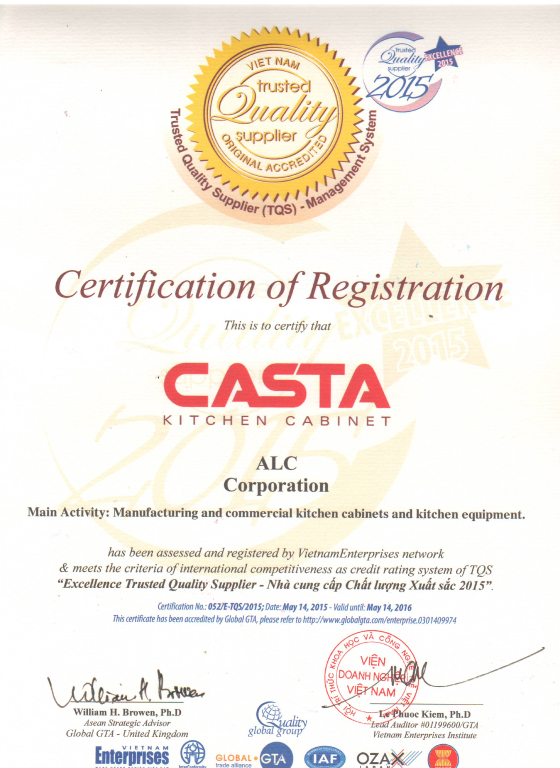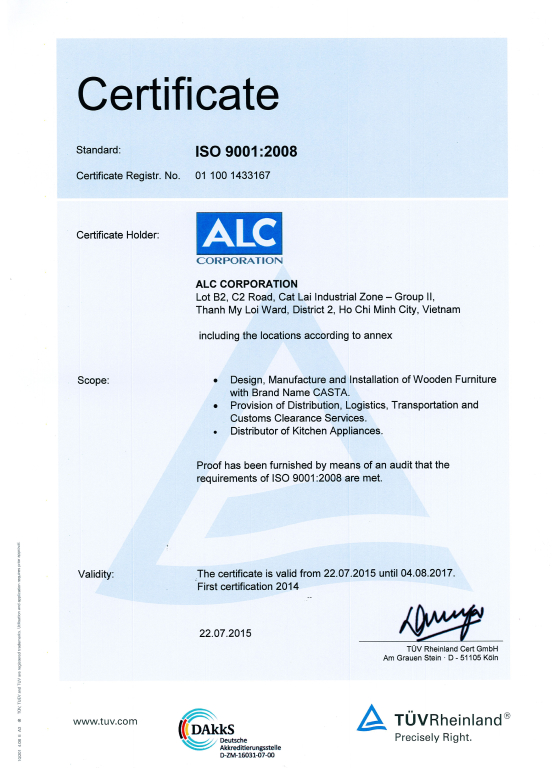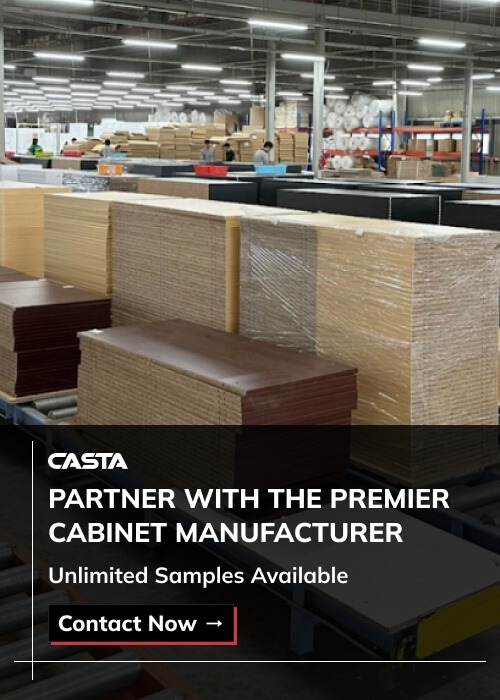Modular-home kitchens often derail schedules and budgets when off-the-shelf cabinets arrive the wrong size or require on-site trimming. Missed deadlines trigger labor overrun, material waste, and costly change orders—eating into your margins.
The right kitchen cabinets for modular homes, engineered to exact 24″-deep base units, moisture-resistant cores, and flat-pack CNC-drilled assemblies, eliminate those headaches. You’ll cut install time by up to 50 percent, avoid costly site modifications, and lock in predictable cabinet costs—so every project stays on time, under budget, and delivers the quality your clients expect.
In this blog, we’ll walk through everything you need— from sizing criteria and material selection to style comparisons, pricing guides, and supplier evaluations—so you can specify the perfect kitchen cabinets for modular homes and deliver flawless installations on every project.
Table of Contents
1. Why Modular Builds Need Smarter Cabinets
Modular housing is booming in North America, and with good reason: the U.S. modular-construction market is forecast to grow by USD 7.04 billion between 2024 and 2029 at a 6.2 percent CAGR. As more builders turn to off-site fabrication, every minute saved on the jobsite translates directly into cost savings—especially when your kitchen cabinets for modular homes arrive ready to install.
That’s why choosing the right kitchen cabinets for modular homes is critical. Cabinets must drop-in to pre-built wall and floor modules without on-site trimming, ensuring installation crews stay on schedule and avoid expensive callbacks. At the same time, these kitchen cabinets for modular homes need the design flexibility and long-term durability that homeowners demand—making ready-to-assemble (RTA) or semi-custom systems the go-to choice for modular projects aiming to balance speed, style, and savings.
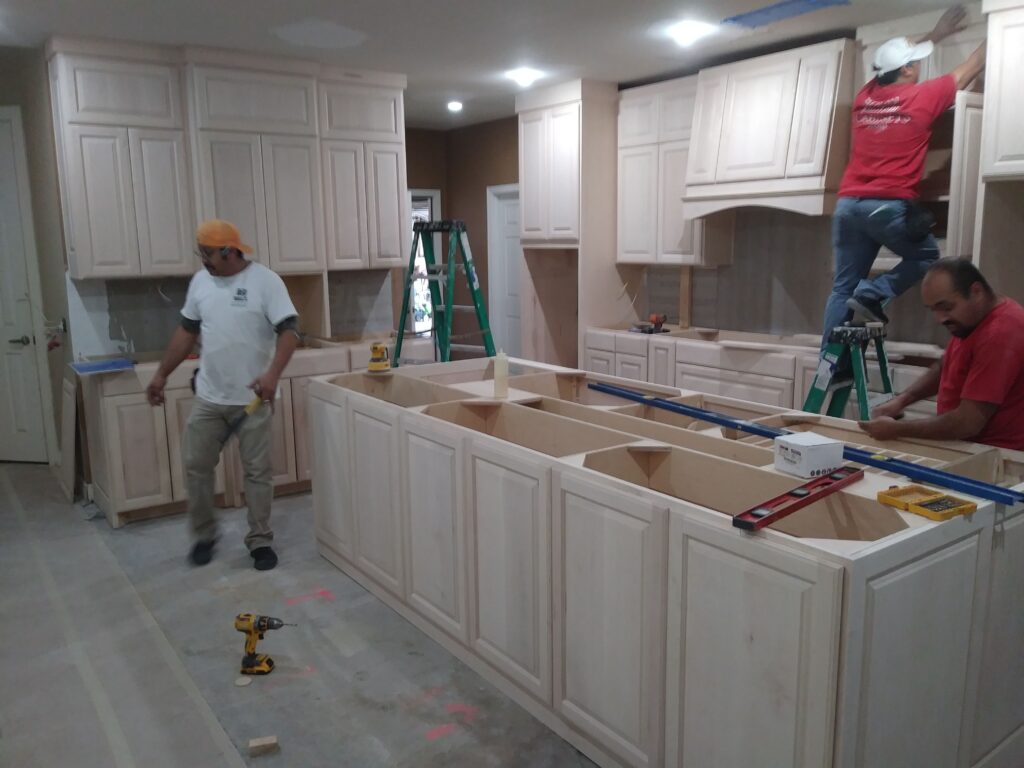
2. What to Look For in Modular-Friendly Cabinets
When evaluating options for kitchen cabinets for modular homes, focus on four key criteria: size compatibility, materials and moisture resistance, pre-drilled convenience, and health-and-safety certifications.
Learn more: What are modular cabinets?
2.1 Size Compatibility
- Base cabinets: Most modular shell openings accept a 24 in depth. Confirm that your cabinets match this standard to avoid costly field adjustments.
- Wall cabinets: Typical depths of 12 in keep walkways clear, with heights ranging from 30–42 in to align with ceiling modules.
- Appliance and fixture clearances: Always cross-check fridge, range, sink, and hood dimensions against your builder’s spec sheets—and order your kitchen cabinets for modular homes only after verifying those clearances.
Learn more: Base cabinet dimensions
2.2 Materials & Moisture Resistance
| Material | Moisture Resistance | Durability | Cost | Use Case |
| MDF + Thermofoil | High | Medium | $$ | RTA modular kitchens |
| Plywood core | Medium–High | High | $$$ | Long-term residential projects |
| Particle board | Low–Medium | Medium | $ | Entry-level or budget builds |
- Plywood delivers the best dimensional stability for kitchen cabinets for modular homes in high-humidity zones.
- MDF + thermofoil offers excellent moisture resistance at a mid-range price point, ideal for budget-savvy modular developers.
Learn more: Difference between mdf and mfc vs plywood vs hdf
- Particle board can suffice in dry, low-traffic applications but must be sealed meticulously in moist conditions.
Learn more: Are particle board cabinets good?
2.3 Pre-Drilled & Knock-Down Ready
CNC-machined pilot holes for hinges, drawer slides, and confirmat screws accelerate on-site assembly and virtually eliminate misaligned hardware. Cabinets arrive flat-packed with clearly labeled parts—so installers can erect complete kitchen cabinets for modular homes up to 50 percent faster than conventional case goods.
2.4 Certifications & Safety
For any project, insist on these certifications to ensure health-safe, code-compliant cabinets:
- CARB Phase 2 / EPA TSCA Title VI for ultra-low formaldehyde emissions.
- FSC Mix-Credit Certification labeling to demonstrate responsible wood sourcing.
- JIS F Four-Star Formaldehyde Standard accreditation when supplying Japanese-owned developments or meeting international standards.
Learn more: Cabinet certification

By prioritizing these four factors—precise sizing, resilient materials, assembly-ready engineering, and full health-safety compliance—you’ll select kitchen cabinets for modular homes that install flawlessly, perform reliably, and deliver the margins your projects require.
3. Six Popular Cabinet Styles for Modular Homes
Selecting the right profile for kitchen cabinets for modular homes isn’t just about looks—it directly impacts installation speed, homeowner satisfaction, and resale value. Below, we compare six in-demand door designs, highlighting how each benefits key stakeholders: developers (install time), homeowners (resale appeal), and designers (aesthetic flexibility).
| Style | Signature Feature | Best Fit | Developer Benefit | Homeowner Benefit | Designer Benefit |
| Shaker | Five-piece, clean-lined fronts | Modern farmhouses; starter homes | Fast, foolproof installation | Timeless appeal boosts resale value | Versatile backdrop for varied décor |
| Slab | Ultra-flat, unframed surfaces | Contemporary urban modules | Minimal hardware reduces install steps | Sleek look commands premium pricing | Perfect canvas for bold colors or stains |
| Flat-panel | Concealed edges, minimal hardware | Compact loft kitchens | Hidden grooves simplify alignment | Low-maintenance finish endures use | Seamless lines accentuate minimalist themes |
| Beadboard | Vertical ribbing adds texture | Country-style prefab cottages | Pre-milled grooves speed assembly | Textured surface hides daily wear | Adds tactile interest; pairs with metals |
| Glass-front | Transparent inserts for open feel | Light-starved interiors | Lighter cabinets reduce lift effort | Displays china—raises perceived value | Showcases backlit displays and styling |
| Louvered | Angled slats for ventilation | Coastal or humid-area projects | Slatted panels ship flat, install quickly | Better airflow protects goods | Introduces subtle pattern and shadow play |
- Developer: Shaker and flat-panel Euro doors integrate precisely with factory-built wall panels, cutting install time by up to 30% and reducing site adjustments.
- Homeowner: Styles like Shaker and glass-front uppers enhance resale value, offering a blend of classic appeal and modern transparency.
- Designer: Slab and beadboard profiles provide a clean backdrop or tactile contrast, enabling seamless coordination with fixtures, hardware, and countertop materials.
Recommendation
For most modular-home contracts, Shaker doors deliver the fastest install and broad market appeal, while semi-custom slab or flat-panel Euro fronts satisfy urban scheme aesthetics with minimal upkeep. Always confirm your chosen profile clears your modular builder’s wall-chase dimensions—and see how these kitchen cabinets for modular homes blend function, style, and profitability on every project.
Learn more: Kitchen cabinet buying guide
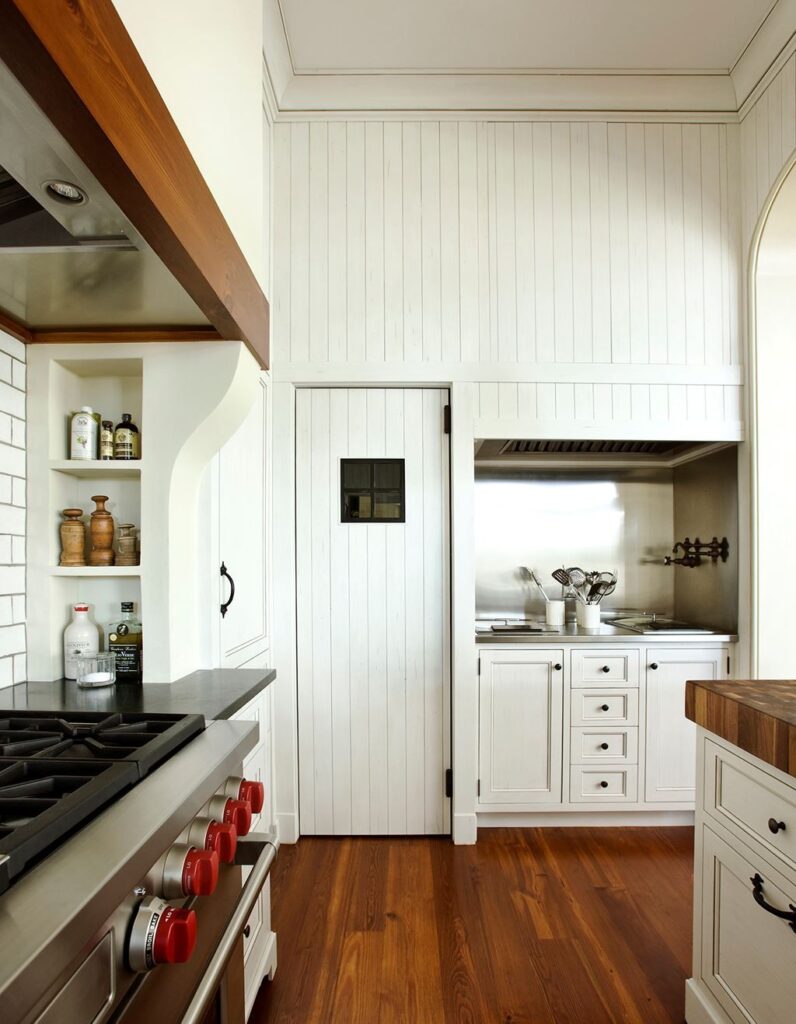
4. Stock vs. Semi-Custom vs. Custom — Balancing Time, Cost & Fit
Choosing the right production level for kitchen cabinets for modular homes, modular home kitchen cabinets, and kitchen cabinets modular home applications means weighing speed, budget, and the precision fit required by factory-built shell dimensions. Below, we compare the three main categories—stock RTA, semi-custom, and full custom—so you can match your project’s timeline, margin goals, and the specific needs of modular home cabinets without sacrificing quality or install efficiency.
| Type | Pros | Cons |
| Stock RTA | • Lead times as short as 2 weeks• Lowest per-unit cost | • Cabinet sizes fixed to catalog specs• Limited color and door-style range |
| Semi-Custom | • Modify widths, heights, and finishes• Hundreds of paint, stain, and door options | • Typical lead times of 3–5 weeks |
| Full Custom | • Precisely engineered to any dimension• Access to premium materials and details | • Lead times extend to 6–10 weeks• Highest investment per unit |
Recommendation & Solution Directions
- Stock (RTA): Best for fast-turnaround projects under 3 weeks—ideal for budget builds with tight install windows that still require reliable kitchen cabinets for modular homes.
- Semi-Custom Plywood RTA: Optimal for most modular home kitchen cabinets. With 3–5 week lead times and the ability to fine-tune to CAD data, you balance speed, cost control, and perfect on-site fit.
- Full Custom: Reserved for high-end prefab or hospitality projects where bespoke finishes, unique hardware, and exact dimensions justify longer lead times and premium investment.
By aligning your project tier with the right production level, you preserve margins, uphold quality, and deliver kitchen cabinets for modular home solutions that are both beautiful and build-ready.Learn more: The difference of RTA, custom vs semi custom cabinets.
Learn more: The difference of RTA, custom vs semi custom cabinets
5. Case Study — How Casta Cabinetry Delivers Modular-Ready Solutions
When specifying kitchen cabinets for modular homes, supply-chain reliability and manufacturing precision are non-negotiable. Casta Cabinetry combines scale, automation, and a streamlined workflow to serve high-volume modular projects without compromising on quality or fit.
5.1 Factory Capacity & Precision
Casta operates over 100 000 m² of factory space split between two Vietnam campuses, enabling production of thousands of kitchen cabinet modules each month.
With 90 percent of operations automated using European CNC systems from Homag, Biesse, and SCM, panel cutting tolerances consistently fall within ±0.1 mm—far tighter than most U.S. installation tolerances. This precision guarantees that every kitchen cabinet for modular homes arrives pre-sized and ready to lock into place, eliminating costly re-cuts on site. At peak output, Casta ships nearly 200 full containers of flat-pack cabinets monthly, supporting multiple modular developments simultaneously.
Learn more: Casta’s OEM Cabinet Manufacturer
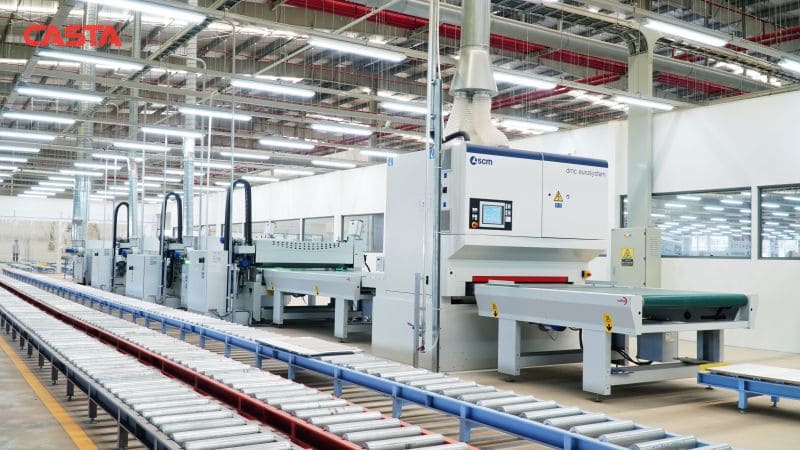
5.2 Design-Iteration Workflow
To align cabinet runs with evolving modular-home layouts, Casta offers an accelerated design iteration process:
- Initial technical review of client CAD files or spec sheets is completed within 24 hours, assuring that all dimensions for kitchen cabinets for modular homes match factory-built shell openings.
- Clients receive 3–5 rounds of photorealistic 3D renders and immersive VR walkthroughs, enabling precise verification of door styles, finishes, and hardware placements before any production begins.
- Finalized cabinet modules are flat-pack labeled by room and module number, with QR codes that link directly to the customer’s BIM or CAD model. This labeling system reduces install time and errors, letting crews erect complete modular kitchen units in a single afternoon.
Learn more: Casta’s Ideal Custom Cabinet Designs
5.3 Compliance & Export Support
International modular projects demand seamless documentation and regulatory adherence. Casta supplies each order with a comprehensive compliance packet—including CARB Phase 2, E1, and FSC Mix-Credit certificates—so that kitchen cabinets for modular homes clear U.S. EPA requirements and sustainable-sourcing audits without delay. All shipping cartons include packing lists, bills of lading, and emission test reports, fast-tracking customs clearance at major North American ports. Typical FOB-to-door lead times range from 30 to 45 days, and contractors report up to 30 percent cost savings compared to comparable Chinese suppliers once U.S. tariffs and freight charges are factored in. These efficiencies make Casta’s modular-ready cabinets a top choice for builders seeking to optimize both schedule and budget.
Learn more: Casta’s Outstanding International Projects
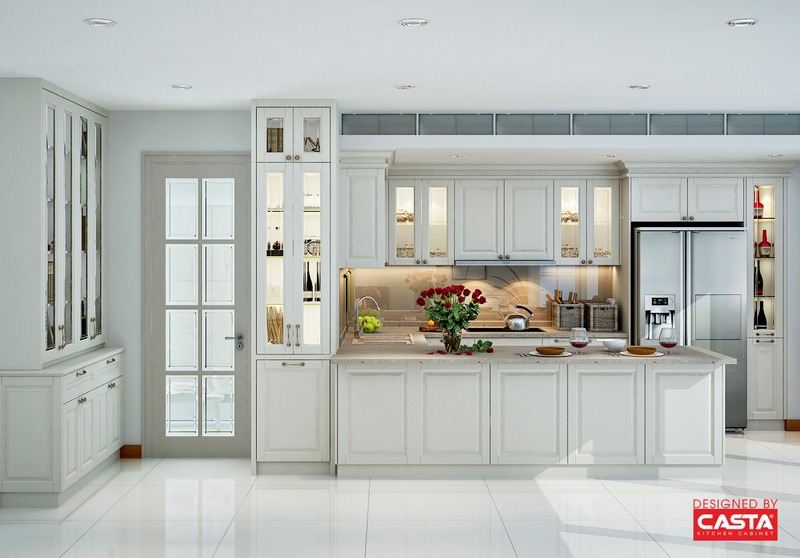
6. Five-Step Buying Framework for Contractors & Brands
Navigating the procurement of kitchen cabinets for modular homes requires a structured approach that aligns project requirements with supplier capabilities. Use this five-step framework to ensure you select the right cabinet type, maintain budget control, and secure on-time delivery.
Step 1: Map the Kitchen Shell
Before you order any cabinets, obtain detailed CAD or technical drawings from your modular-home manufacturer. These drawings should include:
- Exact dimensions of sink, range, refrigerator, and HVAC chases so your kitchen cabinets for modular homes integrate flawlessly with plumbing and electrical modules.
- Wall and floor opening tolerances to verify that standard cabinet depths and heights will clear factory-built channels without on-site trimming.
- Any non-standard corner angles or bulkheads—these require advance notice so your supplier can provide custom fillers or angled corner units.
Thoroughly mapping the kitchen shell up front dramatically reduces the risk of installation delays and change-order costs once cabinets arrive on site.
Step 2: Align Cabinet Type to Budget & Schedule
Choose the production level—stock, semi-custom, or full custom—based on your project’s tier, desired finish level, and timing constraints.
| Project Tier | Cabinet Recommendation | Why It Works |
| Entry-level rental units | Stock MDF with thermofoil | Ships in as little as 14 days; economical solution |
| Mid-market single-family | Semi-custom plywood RTA | Adjustable dimensions; broad palette of finishes |
| High-end prefab or hotels | Full custom mixed-wood panels | Exact specifications; premium veneers and hardware |
Contractors installing kitchen cabinets for modular homes in high-volume, budget-sensitive rental products often choose stock RTA. In contrast, mid-market developments strike a balance with semi-custom plywood solutions that deliver both durability and design flexibility. Luxury modular or hospitality applications justify the investment in full custom cabinets for bespoke finishes and unique brand differentiation.
Sample ROI Comparison
| Cabinet Type | Unit Cost | Install Cost | Contract Price | Margin per Unit |
| Stock RTA (MDF) | $200 | $50 | $400 | $150 |
| Semi-custom (plywood) | $350 | $75 | $700 | $275 |
| Full custom | $500 | $100 | $1,200 | $600 |
Learn more: Leading kitchen cabinet manufacturers
Step 3: Specify Health-Safe Components
Health-sensitive buyers and regulations demand low-emission materials. For all kitchen cabinets for modular homes, require:
- CARB Phase 2 or E1 rated panel cores to minimize formaldehyde off-gassing and comply with U.S. and international air-quality standards.
- Optional UV-cured, water-based finishes to reduce volatile organic compounds (VOCs) by up to 40 percent and support greener building certifications.
Learn more: Non toxic kitchen cabinets
Explicitly listing these requirements in your purchase order prevents last-minute quality discrepancies and ensures cabinet shipments arrive fully compliant.
Step 4: Choose Assembly Style
The right assembly format affects both installation speed and labor cost. Evaluate these options for your modular-kitchen rollouts:
| Assembly Format | Best For | Typical Labor per Cabinet |
| Flat-pack RTA | Volume dealers, DIY installations | 20–30 minutes |
| Factory-assembled | Commercial timelines | 5–10 minutes |
| Plug-and-play modules | Student housing, multi-unit builds | Crane-drop installs |
For fast-track modular projects, flat-pack RTA kitchen cabinets for modular homes allow two-person crews to complete a full kitchen in an afternoon. Where job-site labor is at a premium, pre-assembled or plug-and-play drop-in modules can reduce on-site efforts to under ten minutes per cabinet.
Step 5: Vet Supplier Capabilities
Finally, verify that your chosen supplier can meet both project scale and technical demands. Ask every candidate:
- Minimum order quantity – Can you order partial container loads or smaller batches?
- Lead times and Incoterms – What are your FOB and DDP delivery schedules to North American ports?
- Packaging and drop-test data – Do you comply with ISTA-series packaging standards?
- Warranty and after-sales support – How long is your warranty, and can you supply replacement parts quickly?
- Sample and mock-up options – Will you provide physical door and finish samples or mock-up modules before full production?
Key Takeaway
By following this five-step framework—mapping the kitchen shell, aligning cabinet type to budget and schedule, specifying health-safe components, choosing the optimal assembly style, and vetting supplier capabilities—contractors and brands can confidently source kitchen cabinets for modular homes that fit perfectly, install quickly, comply with stringent safety standards, and protect project margins.
7. 2025 Pricing Guide — What to Expect
When budgeting for kitchen cabinets for modular homes, it’s crucial to understand how material selection, construction method, and finish level impact your per-linear-foot cost of kitchen cabinets for modular homes. Below is a breakdown of typical price ranges for different kitchen cabinets for modular homes tiers in 2025, followed by the key factors that drive these costs—and how offshore manufacturing can yield substantial savings on kitchen cabinets for modular homes.
| Cabinet Tier | USD / Linear Foot | Typical Use |
| Stock MDF + Thermofoil | $150–$200 | Entry-level prefab homes |
| Semi-custom Plywood Core | $200–$300 | Mid-market residential developments |
| Custom Solid Wood Fronts | $300–$450+ | Luxury modular or boutique projects |
- Stock MDF + Thermofoil cabinets start as low as $150 per linear foot because they use standardized panel sizes, pre-finished thermofoil surfaces, and limited door-style options. For developers specifying kitchen cabinets for modular homes in high-volume rental or affordable housing projects, this tier delivers the fastest turnarounds and tightest cost control.
- Semi-custom Plywood Core units fall between $200 and $300 per linear foot. Here, you gain the option to tweak widths, heights, and finish colors while retaining flat-pack RTA convenience—ideal for contractors of single-family kitchen cabinets for modular homes seeking a durable core material plus design flexibility without the premium of bespoke builds.
- Custom Solid Wood Fronts typically begin around $300 per linear foot and can exceed $450, depending on wood species, door profiles, and decorative inlays. These fully tailored systems are chosen for high-end kitchen cabinets for modular homes applications where precise grain-matching and unique hardware justify longer lead times and higher investment.
Cost Factors to Consider
- Material Costs: Plywood and solid-wood veneer cores command higher prices than MDF or particle board.
- Finish Complexity: Painted finishes, thermofoil laminates, or exotic wood stains each add incremental cost.
- Hardware & Accessories: Soft-close hinges, self-closing drawer slides, and integrated organizers increase per-unit expense.
- Assembly & Packaging: Factory-assembled modules cost more upfront but reduce on-site labor; flat-pack kits save labor but require installation time.
- Shipping & Tariffs: Freight terms (FOB vs. DDP), container volumes, and U.S. import duties can swing landed cost by 10–20 percent.
Learn more: Top rated cabinet manufacturers
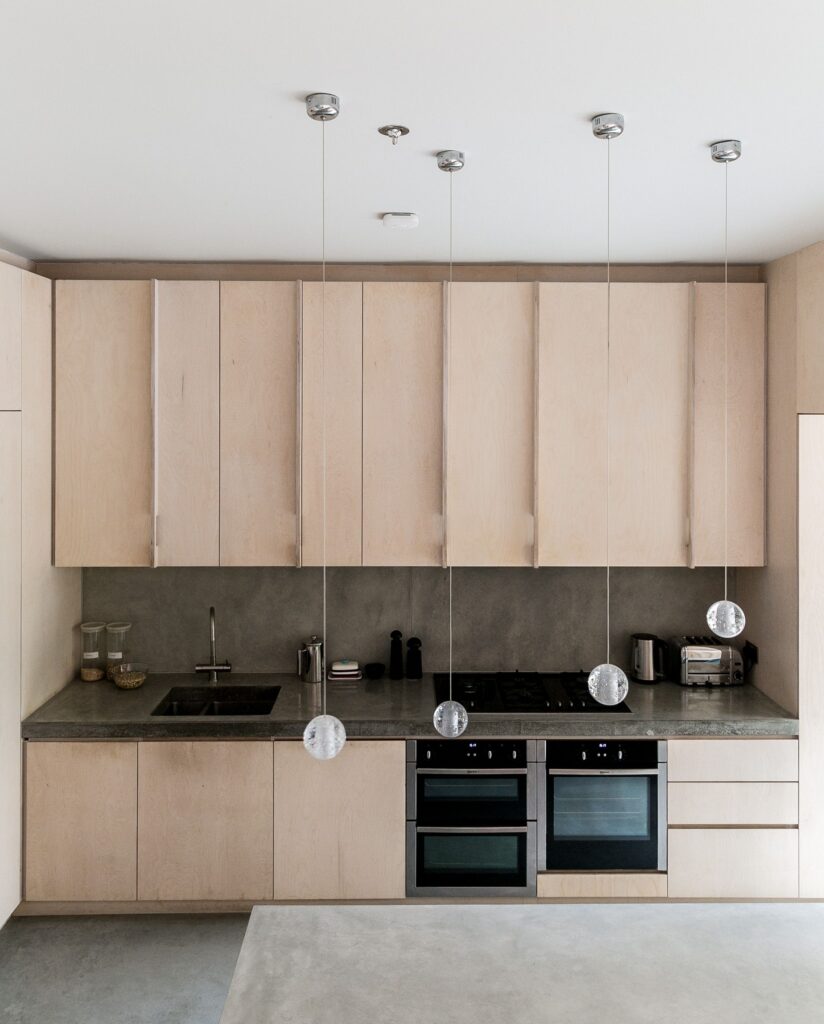
Vietnam-Based Savings
By sourcing kitchen cabinets for modular homes from Vietnam-based factories, U.S. buyers can realize up to 30 percent cost savings compared to domestic or Chinese suppliers. Lower labor rates, efficient high-automation lines, and favorable tariff classifications on wooden furniture combine to drive down the landed price—helping contractors and brands protect their margins while delivering premium-quality kitchen cabinets for modular homes systems.
Learn more: US abolishes tax invasion investigation for Vietnamese wooden cabinets
8. Supplier Showdown — Vietnam vs. China
When sourcing kitchen cabinets for modular homes, choosing the right international partner can significantly impact lead times, landed cost, and design flexibility. Below is a detailed comparison between a leading Vietnam-based manufacturer (Casta Cabinetry) and typical Chinese suppliers.
| Metric | Vietnam (Casta Cabinetry) | China Suppliers |
| Lead time (port-to-port) | 30–45 days | 35–50 days |
| U.S. tariff impact | 0–4 percent | 25–262 percent |
| Semi-custom cost per foot | $200–$300 | $240–$330 |
| Minimum order | 1 × 20 ft container | Full 40 ft container |
| RTA packaging standard | ISTA-6 certified | Varies by plant |
| Design-iteration rounds | 3–5 | 1–2 |
Vietnam-based factories like Casta Cabinetry leverage high automation and favorable trade agreements to ship kitchen cabinets for modular homes in as little as 30 days, compared to the typical 35–50 days from China. Lower or zero tariffs on wood furniture further reduce the total landed cost, making semi-custom plywood cabinets more affordable at $200–$300 per linear foot. Chinese plants often require larger minimum orders and may lack consistent ISTA-6 flat-pack certification, increasing the risk of damaged parts on arrival. Finally, Vietnam’s 3–5 rounds of design iterations give contractors and brands greater confidence that their kitchen cabinets for modular homes will fit precisely and reflect the intended finish—while most Chinese suppliers offer only one or two draft cycles. This supplier showdown highlights why many modular-home builders prefer Vietnam for quality, speed, and cost-effective customization.
Learn more: Vietnam vs China Cabinet Manufacturers: A Comparative Analysis
9. Conclusion
Selecting the right kitchen cabinets for modular homes elevates every project from merely functional to truly outstanding. When you specify kitchen cabinets for modular homes with exacting tolerances, you eliminate on-site fitting challenges and ensure that each module integrates seamlessly with factory-built walls and floors. Choosing low-VOC, certified panel cores not only safeguards indoor air quality but also meets stringent building-code and sustainability requirements. By partnering with Vietnam’s high-automation production lines, you benefit from rapid turnaround times, reduced material waste, lower labor expenses, and predictable landed costs—ultimately protecting project margins and delivering consistently high-quality results on every modular kitchen installation.
10. FAQ — Kitchen Cabinets For Modular Homes
Are RTA cabinets strong enough for modular homes?
What are the standard cabinet depths?
Which certification do I need?
Can cabinets ship direct to job sites?
Do semi-custom modular cabinets affect resale value?
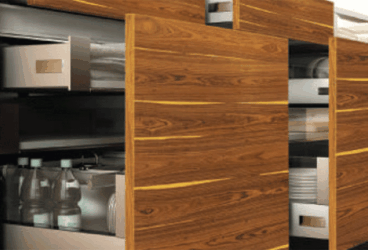
MDF vs Plywood for Kitchen Cabinets – Which is Better?...
MDF vs Plywood for kitchen cabinets is one of the most important decisions contractors and furniture brands must make wh...
11/14/2025 | David Nguyen
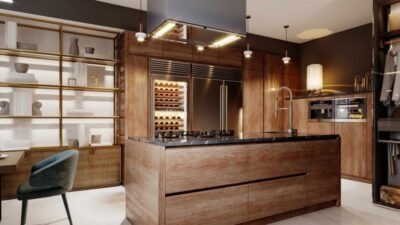
Plywood Kitchen Cabinets: Pros and Cons Explained for Contra...
Plywood kitchen cabinets are now one of the most preferred options in modern kitchen manufacturing, combining durability...
11/12/2025 | David Nguyen
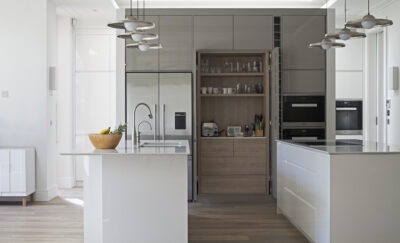
Best Italian Kitchen Cabinets: Modern Design, Precision Craf...
Italian kitchen cabinets represent the gold standard in modern kitchen design — celebrated for their craftsmanship, slee...
10/29/2025 | David Nguyen
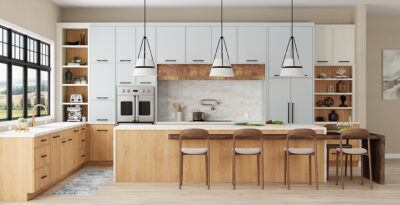
European vs American Kitchen Cabinets: Key Differences &...
European vs American kitchen cabinets is a core decision for anyone specifying cabinetry for modern buildings or homes. ...
10/27/2025 | David Nguyen
Contact us
Casta is always ready to listen and answer all customers' questions
